Plant roots naturally combat riverbank erosion by binding soil particles together and creating stabilization networks. You’ll see the best results using native plants with fibrous root systems, which provide superior tensile strength and absorb excess water. Fast-growing species like willows work alongside shrubs and grasses to protect banks during floods. When properly installed during spring or fall, these living solutions outperform hard structures while creating wildlife habitat. The deeper you explore this approach, the more benefits you’ll uncover.
Understanding the Science of Riverbank Erosion
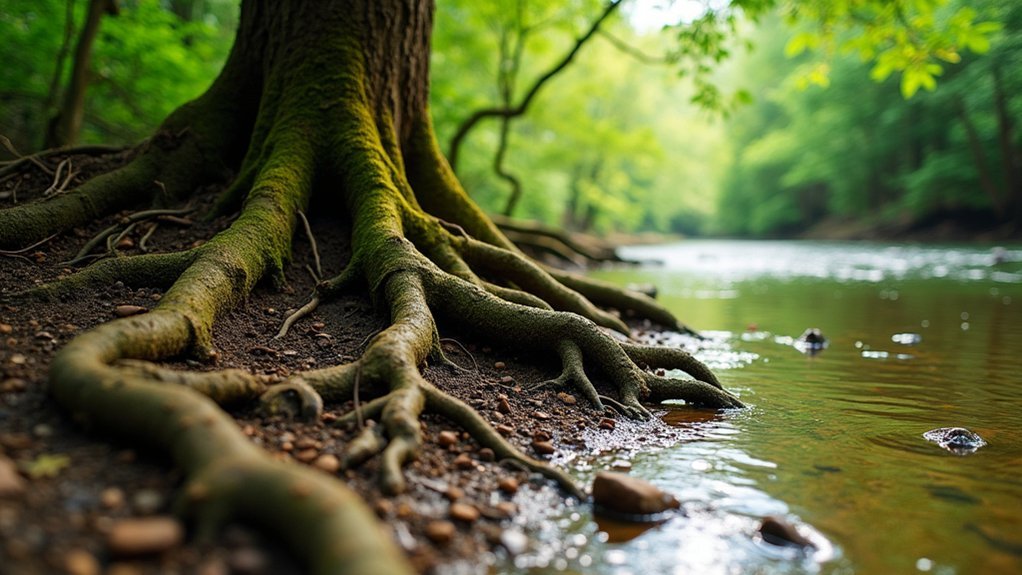
While rivers may appear peaceful from a distance, powerful forces are constantly reshaping their banks through the natural process of erosion.
You’ll notice this activity primarily on the outside of river bends, where fast-moving water aggressively wears away soil while depositing sediment on the inside curves where water slows down.
Several factors can accelerate river bank erosion, including severe flooding, changes upstream, and vegetation removal.
River bank erosion intensifies dramatically through flood events, upstream alterations, and the critical loss of protective vegetation.
What’s particularly important is soil composition—sandy soils erode much faster than clay soils with their stronger bonding properties.
This is where root systems become vital defenders.
Deep-rooted plants with fibrous networks increase soil cohesion and stability.
Research confirms that higher root density directly correlates with lower soil detachment rates during erosion events, effectively armoring vulnerable banks against the river’s persistent force.
How Roots Create Natural Stabilization Systems
Root systems serve as nature’s engineers, creating intricate stabilization networks beneath the soil’s surface. When you plant vegetation with fibrous roots, you’re deploying a powerful erosion control strategy. These fine roots offer greater tensile strength than thicker ones, effectively holding soil particles together during water flow.
| Root Type | Erosion Control Benefit | Water Management |
|---|---|---|
| Fibrous | High soil cohesion | Dispersed uptake |
| Fine | Superior tensile strength | Prevents detachment |
| Dense | Reduces soil loss | Absorbs 20+ gallons daily |
| Native | Riverbank stabilization | Reduces saturation |
Your riverbank plants don’t just slow surface water; their roots form underground networks that physically bind soil together. As root density increases, erosion rates markedly decrease, creating a natural armor that shields banks from the constant forces of flowing water.
Selecting Native Plants With Strong Root Networks
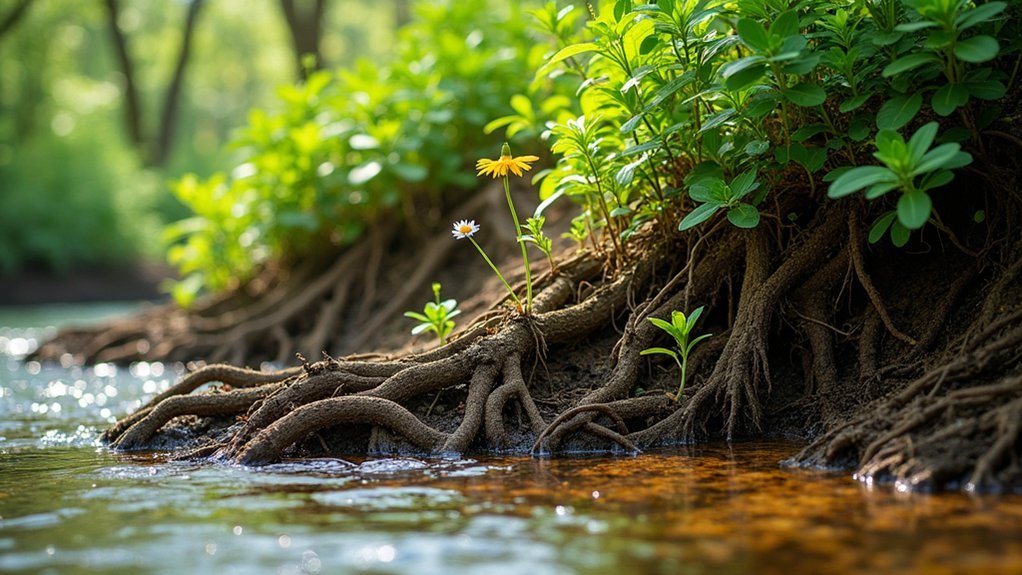
Since the success of any bank stabilization project depends on plant selection, choosing native species with robust root systems should be your top priority.
Look for fast-growing varieties like willows and ferns that develop deep, fibrous roots to anchor soil effectively and combat soil erosion.
You’ll get better results by establishing diverse plant communities rather than monocultures.
Native plants can absorb impressive amounts of water—some taking in over 20 gallons daily during growing season—which reduces soil saturation and erosion risk.
Native vegetation’s remarkable water absorption capacity significantly reduces erosion potential by decreasing soil moisture levels during critical growth periods.
Avoid invasive species that might outcompete beneficial natives.
Instead, select plants adapted to your local conditions for peak performance.
This strategic approach maximizes the erosion-controlling potential of root systems while creating sustainable, self-maintaining bank protection that works with natural processes.
Root Types That Effectively Combat Erosion
Understanding which root structures provide ideal protection stands at the heart of effective erosion control strategies.
When selecting plants to prevent erosion, prioritize those with fibrous root systems rather than tap roots. Fibrous roots create dense networks that greatly enhance soil stability and resist detachment, especially in sandy soils.
You’ll achieve better results with plants featuring high root density (RD) and root length density (RLD), as these metrics directly correlate with reduced erosion rates. Fine roots offer superior tensile strength compared to thicker roots, improving soil cohesion and slope stability.
Be cautious with tap-rooted plants in sandy environments—water can create destructive vortex erosion around their thicker structures.
Research confirms fibrous root systems can drastically decrease concentrated flow erosion, making them your ideal choice for natural bank protection.
Comparing Root Systems: Trees vs. Shrubs vs. Grasses
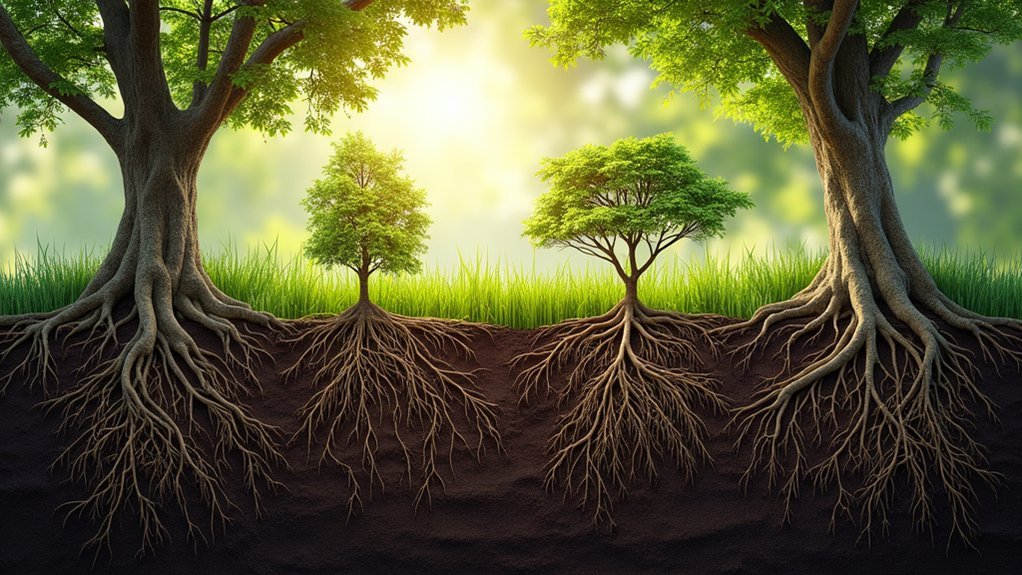
The battle against bank erosion requires strategic selection of appropriate plant types, each offering distinct root architecture advantages.
When you’re planning erosion control, understanding how different root systems function is essential.
Trees develop deep tap roots that anchor firmly into cohesive soils, providing long-term stability against erosion.
Shrubs offer a balanced approach with both tap and fibrous roots, making them ideal for sloped areas.
Grasses, with their dense fibrous networks, excel at stabilizing sandy, non-cohesive soils.
- Trees – Best for deep anchorage in cohesive soils
- Shrubs – Best suited for sloped terrains with combined root types
- Grasses – Superior for sandy soils with high root density
- Mixed plantings – Most effective overall, combining unique benefits of each root type
For maximum erosion control, consider soil type when selecting your vegetation strategy.
Establishing Vegetation Buffers Along Waterways
When creating vegetation buffers along waterways, you’ll need to strategically select native plants with deep, fibrous root systems that can absorb excess water and bind soil particles together.
The benefits of these root networks extend beyond erosion control to include improved water quality, reduced runoff, and enhanced habitat for local wildlife.
You can maximize success by installing buffer plants during their dormant season, using proper spacing techniques, and maintaining adequate moisture until the root systems become established.
Strategic Plant Selection
Selecting the right vegetation for waterside buffers represents an essential step in combating bank erosion.
You’ll want to prioritize native plant species with deep root systems that effectively reduce erosion by anchoring soil along banks.
When choosing plants for your buffer zone, consider these critical factors:
- Root structure – select plants with extensive root systems that penetrate deeply to stabilize soil
- Growth rate – fast-establishing species like grasses and ferns provide quicker protection
- Density potential – plants that create thick coverage will better slow water flow
- Habitat value – diverse plant communities strengthen soil while supporting local wildlife
Remember to assess your site’s specific soil conditions, light exposure, and moisture levels before finalizing your selections.
Wider, denser plantings will maximize your buffer’s effectiveness against erosive forces.
Root System Benefits
After identifying suitable plants for your waterway protection strategy, you’ll need to understand why root systems form the backbone of effective erosion control. These underground networks provide powerful defense against stream bank erosion while offering numerous ecological benefits.
| Root Type | Erosion Control Benefit | Best Applications |
|---|---|---|
| Fibrous | Binds non-cohesive soils | Sandy, loose soils |
| Deep | Stabilizes larger soil masses | Steep banks |
| Diverse | Creates multi-level protection | All waterways |
When you establish vegetation buffers with diverse root system benefits, you’re not just preventing erosion—you’re creating a living infrastructure that absorbs up to 20 gallons of water daily per plant. The dense network of roots acts like natural rebar, holding soil particles together even during high-flow events, while supporting wildlife and enhancing ecosystem health along your waterways.
Installation Best Practices
Successful erosion control depends on proper installation techniques when establishing vegetation buffers along waterways. When planting along river banks, select native species with deep, fibrous roots that effectively bind soil and resist erosive forces.
Before introducing natural vegetation, assess your site conditions:
- Analyze soil composition and moisture patterns to match plants with their ideal growing environment.
- Include a mix of fast-growing species for quick stabilization alongside long-term perennials.
- Plant in ideal seasons (typically spring or fall) to guarantee strong establishment before extreme weather.
- Space plants appropriately to account for mature growth while providing immediate coverage.
Maintain your buffer by regularly monitoring for invasive species and guaranteeing adequate growth conditions.
This systematic approach guarantees your vegetation buffer will provide long-lasting erosion control while enhancing local habitat.
Seasonal Considerations for Plant Establishment
While the right plant selection is essential for bank stabilization, timing your planting efforts can make the difference between thriving vegetation and failed erosion control.
Spring and early fall offer ideal conditions for establishing your erosion control system. These seasons provide the moderate temperatures and consistent moisture that new roots need to develop properly.
You’ll want to avoid late summer plantings when drought can stress young plants and reduce their survival rate.
Consider using native plants that have evolved to thrive in your local climate conditions. They’ll require less irrigation once established and better withstand seasonal flooding that might wash away newer vegetation.
Keep a close eye on soil moisture during the establishment phase. Neither waterlogged nor parched conditions will support the healthy root development you need for effective bank stabilization.
Combining Root Systems With Other Natural Solutions
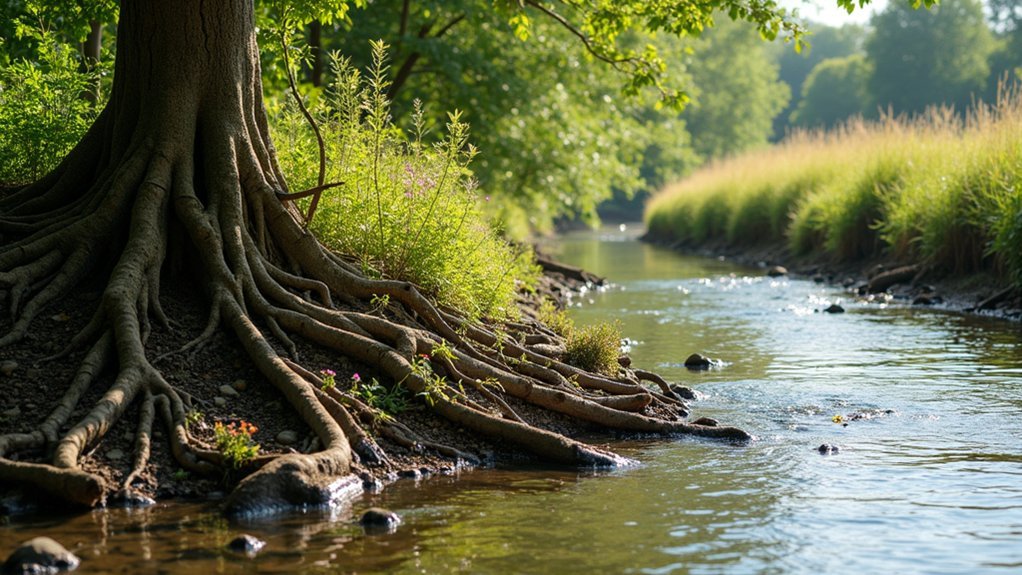
The most effective bank stabilization strategies combine fibrous root systems with complementary natural solutions to create a defense network against erosion.
Fibrous root systems interlock with natural materials, creating living armor that grows stronger as nature’s erosion defense matures.
When you’re planning your river bank protection, consider how natural materials can work together with vegetation for maximum effectiveness.
- Integrate coir logs along the water’s edge to absorb impact while roots establish themselves.
- Layer biodegradable erosion control mats that protect soil while allowing plant roots to penetrate.
- Create a diverse plant community with fast-growing native species to rapidly increase root density.
- Use a combination of shallow and deep-rooted plants to stabilize different soil layers.
This layered approach not only prevents soil detachment during heavy rainfall but also enhances the local ecosystem while providing sustainable protection for your river bank.
Case Studies: Successful Riverbank Restoration Projects
Throughout North America and Europe, impressive riverbank restoration projects have demonstrated how root systems can transform eroded shorelines into stable, thriving ecosystems.
In Georgia, native willows and dogwoods restored 2,000 feet of Chattahoochee River banks, considerably reducing erosion and improving water quality.
Portland’s Willamette River project achieved a 50% decrease in sedimentation by replanting native vegetation that stabilized the stream banks through robust root networks.
The San Francisco Bay’s “Living Shorelines” initiative combined native grasses with biodegradable materials, cutting erosion by 30% over five years.
Similarly, the Thames River project in the UK integrated deep-rooted reeds and sedges, reducing erosion by 40%.
Maine’s Saco River restoration saw a remarkable 70% increase in soil stability through strategic riparian buffer planting.
Cost Benefits of Root-Based Erosion Control
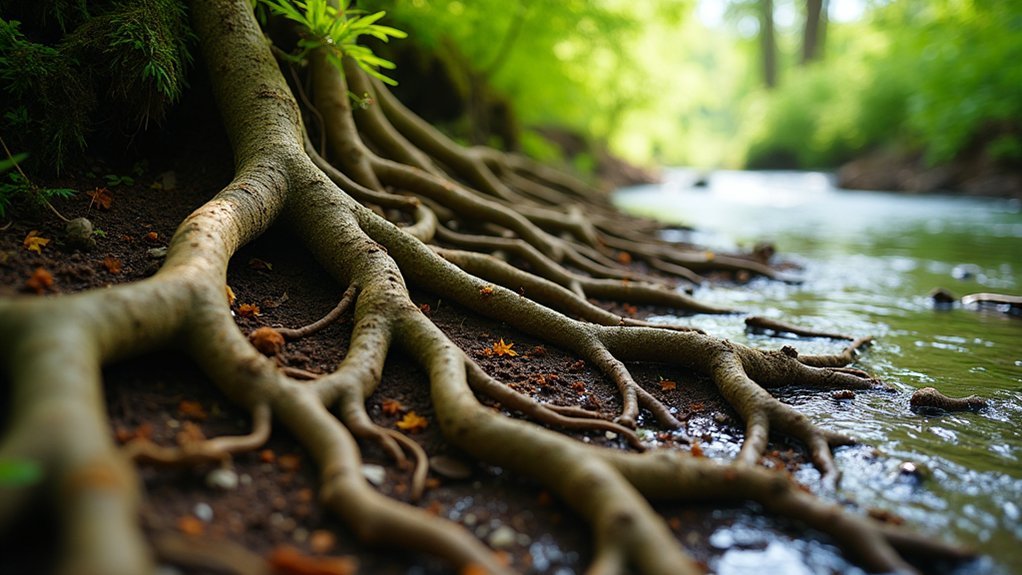
You’ll find that root-based erosion control drastically cuts your infrastructure expenses by reducing the need for costly hard armoring methods by up to 40%.
Your investment in native plants pays off through decreased maintenance requirements and fewer emergency repairs to damaged banks over time.
A thorough long-term savings analysis reveals that vegetation-based strategies not only protect your investment initially but continue to provide increasing financial benefits as plant communities mature and strengthen.
Reduced Infrastructure Expenses
When communities face rising costs of shoreline management, root-based erosion control presents a financially attractive alternative. By implementing natural restoration projects with native plants, you’ll greatly reduce infrastructure expenses while achieving effective erosion control.
Your community can benefit from these cost-saving advantages:
- Up to 40% reduction in implementation costs compared to traditional hard armoring like rip rap.
- Minimal long-term maintenance expenses as diverse plant communities self-regulate and strengthen over time.
- Decreased need for expensive repairs or replacements of engineered structures that typically fail within 10-15 years.
- Elimination of costly specialized equipment and materials required for hard infrastructure installation.
Long-Term Savings Analysis
Understanding the long-term financial benefits of root-based erosion control reveals a compelling economic case. When you invest in native plants with deep root systems, you’ll reduce maintenance costs by up to 40% compared to traditional hard armoring methods like rip rap.
Your property gains significant protection as these roots effectively stabilize riverbanks, potentially saving you thousands in structural reinforcements and repairs. The vegetation strategy you implement doesn’t just combat erosion—it enhances ecosystem health, which can increase your property value as surrounding habitats flourish.
You’ll also contribute to decreased sedimentation in waterways, indirectly saving communities the $1 million per mile typically spent on dredging.
Since native plants require less frequent intervention than non-natives, you’ll continue to accumulate savings in labor and materials for years to come.
Maintenance Tips for Healthy Erosion-Control Plantings
Once established, erosion-control plantings require consistent care to maximize their soil-stabilizing potential. To guarantee your vegetation effectively protects your bank from erosion, follow these essential maintenance practices:
- Monitor soil moisture regularly – Native trees can absorb over 20 gallons daily during growing season, so adequate water guarantees strong root development for bank stability.
- Apply mulch around plants – This retains moisture, suppresses weeds, and improves soil structure, supporting healthier root systems.
- Prune periodically – Regular maintenance promotes dense growth patterns, creating more effective barriers against soil loss.
- Avoid chemical treatments – Fertilizers and pesticides harm beneficial soil organisms that contribute to plant health and erosion control.
Incorporate diverse native species, including fast-growing ferns and grasses, to create a resilient system that prevents erosion while minimizing long-term maintenance costs.
Frequently Asked Questions
Do Plant Roots Help Prevent Erosion?
Yes, plant roots help prevent erosion. You’ll find they’re extremely effective at holding soil in place by creating dense networks that increase soil cohesion and stability, especially when you’ve got fine, fibrous root systems.
How Do I Stop My Bank From Eroding?
You’ll stop your bank from eroding by planting native trees and shrubs with deep roots, installing biodegradable erosion control mats, anchoring fallen trees to slow water flow, and establishing diverse vegetation along the bank.
Which Root Prevents Soil Erosion?
Fibrous root systems best prevent soil erosion. You’ll find these in grasses and native plants. They create dense networks of fine roots that hold soil particles together and absorb excess water that might otherwise wash away topsoil.
What Is the Best Plant to Stop Soil Erosion?
For stopping soil erosion, you’ll find native plants with fibrous root systems like willows and ferns most effective. They’ll bind soil together while fast-growing native grasses absorb water and improve soil stability.
In Summary
You’ve learned how plant roots offer a powerful, sustainable solution to bank erosion. By selecting the right native species and combining complementary root systems, you’ll create living infrastructure that strengthens over time. You’re not just preventing erosion—you’re rebuilding ecosystems while saving money. With proper maintenance, your root-based approach will protect your riverbanks for generations, proving that nature’s engineering often surpasses our own.

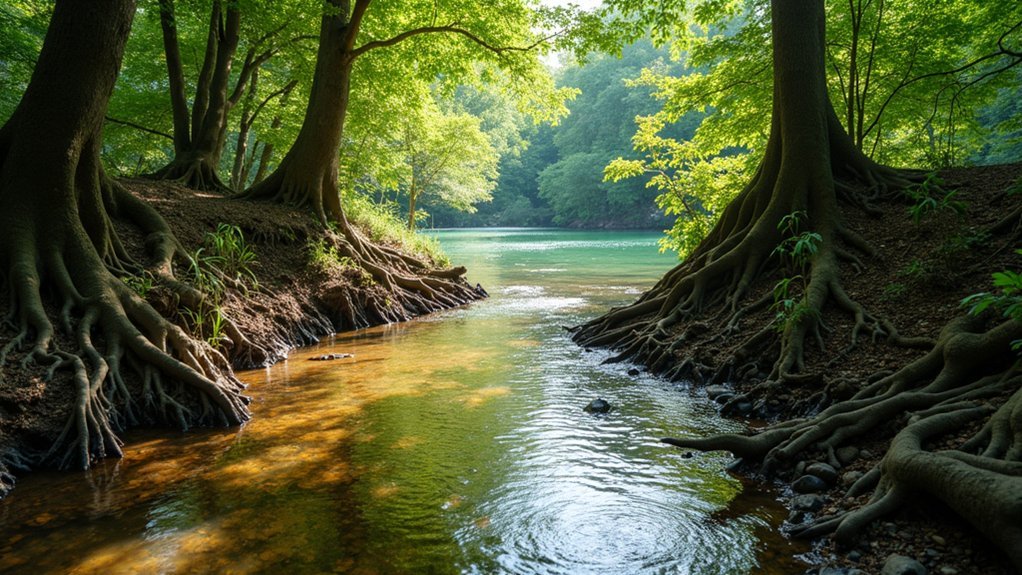



Leave a Reply